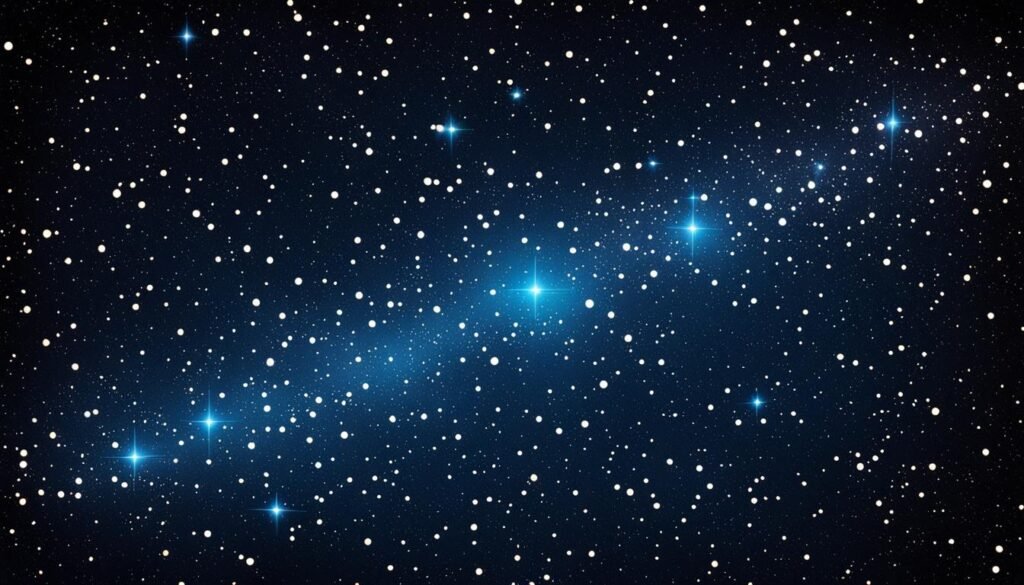| Genitive | Cephei |
| Abbreviation | Cep |
| Pronunciation | (ˈsiːfiəs) o (ˈsiːfjuːs) |
| Main Stars | 7 |
| Brightest Star | α Cep (Alderamin) (2.45m) |
| Right Ascension | 20 hours to 9 hours |
| Declination | 88 deg to -53 deg |
| Sq. Deg. Area | 588 |
| Crosses Meridian | 9PM, Nov |
| Visible Lat. Range | +90, -10 deg (°) |
| Best Viewing Season | Autumn (Northern Hemisphere) |
When you gaze into the vast expanse of the observable night sky, the Constellation Cepheus presents itself as a dramatic tableau of celestial wonders. Enriching the northern hemisphere, this constellation not only carries the weight of myth and legend but also serves as a beacon for cosmic features that inspire awe and curiosity. From the fiery hues of the Garnet Star, Mu Cephei, to the enigmatic depth of the Fireworks Galaxy, Cepheus holds treasures that both novice and seasoned stargazers earnestly seek to decipher.
Spanning across 588 square degrees of the celestial canvas, Cepheus is a spectacle of starry magnificence, plotting an essential chapter in the cosmic atlas since the era of Ptolemy’s 2nd-century astronomy. Your exploration of the constellation will uncover stars that have narrated ancient myths and are home to colossal stars like VV Cephei, inviting you to delve deeper into the storied constellation’s past and present.
Key Takeaways
- Cepheus is a significant constellation connected to ancient Greek mythology, offering a night sky tale of history and astronomy.
- It is the 27th largest constellation, occupying a substantial sky area between the latitudes of +90° and -10°.
- This constellation houses remarkable celestial bodies, including the Garnet Star and deep sky wonders like the Bow-Tie and Iris Nebulae.
- Discover the ties between neighboring constellations of Cassiopeia and Andromeda, bound together by mythical narratives.
- Traverse a section of the sky rich in stellar lore, and witness the stories unfold across 588 square degrees of celestial realm.
- Viewable from the northern hemisphere, Cepheus remains a constellation of academic interest and stargazing pleasure.
Exploring the Myth Behind Constellation Cepheus
Embark on a celestial journey through ancient Greek mythology Cepheus. You will discern the rich tapestry woven with tales of King Cepheus, a figure of grandeur ordained to reside among the constellations as the celestial king. This exploration connects the heavenly depictions on the constellation map directly to the intriguing stories that frame the family constellations including Cassiopeia and Andromeda.
King Cepheus: The Royal Figure in the Sky
King Cepheus, whose esteem in mythology Cepheus reflects a lineage favored by the gods, plays a pivotal role in celestial narratives. Myth suggests that Cepheus, a descendant of the nymph Io and Zeus, was so revered that Zeus himself immortalized him as a constellation. The dominions once ruled by this mortal king stretch across a region that, in today’s geography, includes Egypt, Israel, and Jordan – a testament to the historical grandeur associated with his name.
Cassiopeia and Andromeda: A Family Among the Stars
The story of Cepheus is intertwined with that of his wife and daughter. Cassiopeia, his queen, known for her unmatched beauty and vanity, and Andromeda, their cherished daughter, are contiguous constellations that echo the family ties in the stars. These family constellations encapsulate themes of sacrifice and heroism, crafting an enduring celestial legend that pervades the heavens.
Zeus’s Celestial Honors: From Myth to Constellation
Astral tribute is paid to King Cepheus by the revered deity, Zeus, ensuring his eternal presence in the night sky. This constellation honors his contribution to the ancient myths, placing him forever amongst the stars that travelers and astronomers gaze upon in wonder. The constellation of Cepheus, preserved through Zeus’s celestial decree, narrates an everlasting saga of divinity and honor.
- Constellation Map: A visual guide connecting the mythology of King Cepheus with the stars.
- Mythological Legacy: The narrative of Cepheus and his family immortalized in the heavenly sphere.
- Zeus’s Patronage: The role of the king of gods in elevating mortals to celestial prominence.
Key Characteristics of the Constellation Cepheus
As an enthusiast of the cosmos, you’re likely already aware that the constellation Cepheus houses some of the most captivating Cepheus major stars, noteworthy for their distinct characteristics and the nurturing environment they create for star formation Cepheus. Boasting a tapestry of varied celestial bodies, this constellation’s role in the grand tapestry of the night sky is unraveling anew with each astronomical discovery.

Alderamin, or Alpha Cephei, illuminates as the brightest beacon within this celestial arrangement. The importance of this star hardly ends at its luminosity; it has a retinue of planets circling it, highlighting the wide-ranging potential for celestial study and understanding within Cepheus. Unlike many other constellations, Cepheus does not include Messier objects among its stellar surprises, which makes it even more unique in the eyes of astronomers and stargazers like you.
- Alderamin (Alpha Cephei) – The brightest star of Cepheus
- Alfirk – A peculiar type of variable star
- Errai – Soon to be our North Star due to precession
- Kurhah – A star with an intriguing icy spectral signature
These stars are not just distant suns but personalities within the larger narrative of Cepheus, each approved and christened by the International Astronomical Union (IAU). Present in the fourth quadrant of the northern hemisphere (NQ4), Cepheus shares the sky with other storied constellations, such as Camelopardalis, Cassiopeia, and Ursa Minor, making it a fixture in the astronomical community’s conversation on stars and their births.
Your gaze into the night sky, seeking these fiery jewels, is more than a casual glance—it is a foray into a region where the universe showcases its vibrant processes of creation. Observing Cepheus, you engage with a corner of infinity where stars spring into existence, and the vastness of space comes alive with energy and light. So go ahead, aim your telescope at Cepheus and let the celestial ballet of this star-studded realm guide your exploration of the cosmos.
Constellation Cepheus: A Celestial Guide
As you begin to decipher the mysteries of the night sky, the Cepheus constellation map serves as a perfect starting point for both amateur stargazers and seasoned astronomers alike. Characterized by its iconic house-like shape, Cepheus marks a playground in the cosmos filled with stellar tales and astronomical wonders.

Deciphering Cepheus’ Location in the Night Sky
Your quest to locate Cepheus in the night sky is facilitated by the constellation’s clear celestial location. It proudly sits at right ascensions from 20h 01m to 09h 03m and declinations from +88.6638870° to -53.3532715°. During the months of August and September, look towards the upper right of Polaris, also known as the North Star, and let the faint yet distinctive outline of Cepheus guide you.
Finding Neighboring Constellations Next to Cepheus
Embark on a cosmic journey as you explore the neighboring constellations adjacent to Cepheus. Prepare your eyes for a celestial dance with Cassiopeia, Cygnus, and Camelopardalis, each contributing to the grand tapestry that decorates our northern sky. Understanding these stellar relationships enriches your experience and appreciation of the wider universe.
Navigating the Stars with a Constellation Map
With the IAU’s constellation map at your disposal, navigating the stars becomes an engaging adventure. You, as an aspiring celestial navigator, can trace the pathways from Cepheus to its surrounding constellations. Whether charting courses for celestial tales or simply in awe of the cosmic beauty, let the map be your steadfast companion in unraveling the secrets held by the constellations.
Majestic Celestial Bodies within Cepheus
As you gaze up into the vastness of the night sky, the constellation Cepheus presents itself as a celestial gallery of extraordinary stars. At the heart of Cepheus lies Mu Cephei, famed as the Garnet Star for its deep red coloration that rivals the luminosity of the distant firmament. This distinguished red supergiant, recognized for its magnitude that outshines our own Sun, would engulf the inner planets of the Solar System with its colossal radius. The phantasmagoric sight of Mu Cephei in the night sky is a spectacle that continues to captivate astronomers and laypeople alike.
Complementing the dynamic nature of this constellation is the remarkable VV Cephei, a binary system where celestial choreography unfolds over decades. This monstrous star showcases eclipses of grandiose proportions, boasting a radius that could stretch beyond the asteroid belt. Its complex nature provides insights into the life cycles of some of the largest celestial bodies within Cepheus and the observable universe. Studying these leviathans gives you a window into the enigmatic interactions that govern our galaxy.
The expanse of this ancient constellation is indeed a playground for the behemoth stars that constitute the celestial bodies of Cepheus. As you trace the lineage of these titans across the cosmos, considering their relation to the Earth and human comprehension of space, each glance skyward becomes a journey through time itself. Indeed, Mu Cephei and VV Cephei stand as monumental pillars within this stellar kingdom, anchoring the deep and rich tapestry that is Cepheus amongst the celestial spheres.
FAQ
What is the Constellation Cepheus and what are its celestial wonders?
The Constellation Cepheus is a remarkable constellation located in the northern hemisphere’s observable night sky. It is renowned for its celestial wonders that include an array of stars, nebulae, and other celestial bodies. Named after the mythical King Cepheus of Aethiopia, it’s a constellation of great historical and astronomical significance.
Who was King Cepheus in ancient Greek mythology, and how is he depicted in the stars?
In ancient Greek mythology, King Cepheus was the ruler of Aethiopia and the husband of Cassiopeia. According to myth, Cepheus was placed in the sky by Zeus and is depicted as a celestial king seated on his throne. The stars in the constellation map create an imagery of the king, linking him to the family constellations of Cassiopeia and Andromeda.
What is the significance of Zeus in the constellation of Cepheus?
Zeus, the king of the gods in Greek mythology, is credited with placing King Cepheus among the stars as a constellation, thus bestowing upon him celestial honors. This immortalization in the stars was a depiction of Zeus’s recognition of Cepheus’ mythological importance and his connection to the family of constellations.
What are the major stars and star formations in Cepheus?
The Constellation Cepheus is distinguished by various major stars and star formations including Alderamin (Alpha Cephei), which is its brightest star, as well as notable stars such as Alfirk, Errai, and Kurhah. It also includes significant star formations and celestial bodies that contribute to the constellation’s notability.
How can one decipher Cepheus’ location in the night sky?
To find Cepheus in the night sky, you can look to the upper right of Polaris, the North Star, particularly in the months of August and September. Its distinctive house-like shape makes it easier to identify in the fourth quadrant of the northern hemisphere (NQ4).
What are the neighboring constellations next to Cepheus and how do they relate to Cepheus?
Cepheus shares borders with several constellations including Cassiopeia, Cygnus, and Camelopardalis. These neighboring constellations form a cosmic network of interconnected star patterns and together they create a rich tapestry that enhances the celestial map.
How do I use a constellation map to navigate the stars in Cepheus?
A constellation map, approved by the International Astronomical Union, is a valuable tool for stargazers to navigate the stars in Cepheus. Such maps provide detailed guidance on locating and understanding the positions of constellations in the night sky, adding depth to the stargazing experience.
What are some of the majestic celestial bodies found within Cepheus?
Celestial bodies within Cepheus include the impressive red supergiant Mu Cephei, also known as the Garnet Star, and the eclipsing binary giant VV Cephei. These stars reflect the constellation’s splendor with their massive sizes and luminosity, making them standout features within Cepheus.







